- Clone
- MIH24 (See other available formats)
- Regulatory Status
- RUO
- Other Names
- TRANCE (TNF-related activation-induced cytokine receptor), CD254, RANK-L (receptor activator of NF-κB ligand), OPGL (Osteoprotegerin ligand), SOFA, TNFSF-11
- Isotype
- Mouse IgG2b, κ
- Ave. Rating
- Submit a Review
- Product Citations
- publications
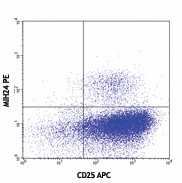
-

PHA-stimulated human peripheral blood mononuclear cells (3 days) stained with CD25 (clone BC96) APC and MIH24 PE -

PHA-stimulated human peripheral blood mononuclear cells (3 days) stained with CD25 (clone BC96) APC and mouse IgG2b, κ PE isotype control -

Human RANKL transfected P815 cells stained with MIH24 PE
| Cat # | Size | Price | Save |
|---|---|---|---|
| 347503 | 25 tests | ¥37,620 | |
| 347504 | 100 tests | ¥75,020 |
Human CD254, also known as RANKL, TRANCE, and OPGL, is a type II transmembrane protein in the TNF superfamily that has two forms: a membrane-anchored protein and a secreted protein. Its extracellular domain is related to TRAIL, FasL, and TNF. CD254 is expressed on osteoblasts and activated T cells. It has been implicated in the regulation of the interactions between T cells and dendritic cells. It plays an important role in osteoblast differentiation and bone resorption. CD254 activates JNK and NF-κB and induces the expression of IL-1, IL-6, IL-12, and IL-15 in dendritic cells.
Product DetailsProduct Details
- Verified Reactivity
- Human
- Antibody Type
- Monoclonal
- Host Species
- Mouse
- Immunogen
- RANKL-transfected L cells
- Formulation
- Phosphate-buffered solution, pH 7.2, containing 0.09% sodium azide and BSA (origin USA)
- Preparation
- The antibody was purified by affinity chromatography, and conjugated with PE under optimal conditions.
- Concentration
- Lot-specific (to obtain lot-specific concentration and expiration, please enter the lot number in our Certificate of Analysis online tool.)
- Storage & Handling
- The antibody solution should be stored undiluted between 2°C and 8°C, and protected from prolonged exposure to light. Do not freeze.
- Application
-
FC - Quality tested
- Recommended Usage
-
Each lot of this antibody is quality control tested by immunofluorescent staining with flow cytometric analysis. For flow cytometric staining, the suggested use of this reagent is 5 µl per million cells in 100 µl staining volume or 5 µl per 100 µl of whole blood.
- Excitation Laser
-
Blue Laser (488 nm)
Green Laser (532 nm)/Yellow-Green Laser (561 nm)
- Application Notes
-
Additional reported applications (for the relevant formats of this clone) include: ELISA and immunohistochemical staining of paraffin-embedded tissue sections2.
-
Application References
(PubMed link indicates BioLegend citation) -
- Kanamaru F, et al. 2004. Immunol. Lett. 94:239.
- Mueller A, et al. 2014. Arthritis Res. Ther. 16:R55. (IHC) PubMed
- Product Citations
-
- RRID
-
AB_2256264 (BioLegend Cat. No. 347503)
AB_2256264 (BioLegend Cat. No. 347504)
Antigen Details
- Structure
- A TNF superfamily member.
- Distribution
-
Expressed on osteoblasts and activated T cells.
- Function
- Plays an important role in osteoblast differentiation and bone resorption, regulates the interactions between T cells and dendritic cells, and T cells and B cells.
- Ligand/Receptor
- RANK, OPG.
- Cell Type
- T cells
- Biology Area
- Immunology
- Molecular Family
- CD Molecules, Cytokines/Chemokines
- Antigen References
-
1. Wiethe C, et al. 2003. J. Immunol. 171:4121
2. Page G, et al. 2005. Arthritis Rheum. 52:2307
3. Ji JD, et al. 2009. J. Immunol. 183:7223 - Gene ID
- 8600 View all products for this Gene ID
- UniProt
- View information about CD254 on UniProt.org
Related FAQs
- What type of PE do you use in your conjugates?
- We use R-PE in our conjugates.
Other Formats
View All CD254 Reagents Request Custom Conjugation| Description | Clone | Applications |
|---|---|---|
| Purified anti-human CD254 (TRANCE, RANKL) | MIH24 | FC,ELISA,IHC-P |
| PE anti-human CD254 (TRANCE, RANKL) | MIH24 | FC |
| APC anti-human CD254 (TRANCE, RANKL) | MIH24 | FC |
| TotalSeq™-A0356 anti-human CD254 (TRANCE, RANKL) | MIH24 | PG |
| TotalSeq™-C0356 anti-human CD254 (TRANCE, RANKL) | MIH24 | PG |
| TotalSeq™-B0356 anti-human CD254 (TRANCE, RANKL) | MIH24 | PG |
Customers Also Purchased
Compare Data Across All Formats
This data display is provided for general comparisons between formats.
Your actual data may vary due to variations in samples, target cells, instruments and their settings, staining conditions, and other factors.
If you need assistance with selecting the best format contact our expert technical support team.
-
Purified anti-human CD254 (TRANCE, RANKL)
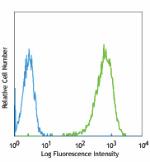
Human RANKL transfected P815 cells stained with MIH24 PE -
PE anti-human CD254 (TRANCE, RANKL)
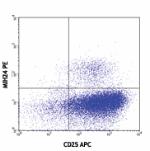
PHA-stimulated human peripheral blood mononuclear cells (3 d... 
Human RANKL transfected P815 cells stained with MIH24 PE 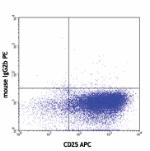
PHA-stimulated human peripheral blood mononuclear cells (3 d... -
APC anti-human CD254 (TRANCE, RANKL)
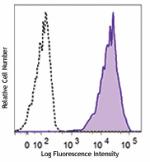
Human RANKL transfected P815 cell line was stained with CD25... -
TotalSeq™-A0356 anti-human CD254 (TRANCE, RANKL)
-
TotalSeq™-C0356 anti-human CD254 (TRANCE, RANKL)
-
TotalSeq™-B0356 anti-human CD254 (TRANCE, RANKL)











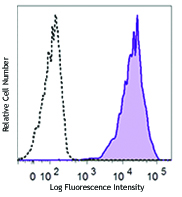
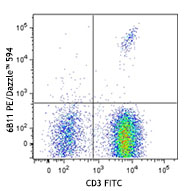

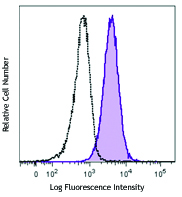



Follow Us